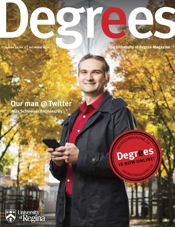Spot Light

Meet Alex King, the University of Regina’s curator of the President’s Art Collection.
- What are some of the important details of the acquisition of the President’s Art Collection?
- The vast majority of artwork comes to us through donation. Donors approach us with artwork they’d like to gift, and we review based on the needs of the collection, our ability to display and care for it, and so on. We’re also supported through the office of the President with the Annual Indigenous Acquisition, which has allowed us to purchase contemporary work since 2019.
- How are decisions to acquire artwork made?
- Acquisition decisions are made by the President’s Advisory Committee on Art. We discuss the artwork together, considering factors like the merits of the work, the artist’s overall practice, its condition and any associated costs (such as conservation and display apparatus), plus any ethical concerns. We prioritise artwork by artists associated with the University, such as former faculty and students. I’m really proud that the collection tells the story of artistic practice in southern Saskatchewan, and, in particular, the University’s role in nurturing an environment where that became possible. We’re also aware of gaps in the collection that need to be redressed – namely work by BIPOC artists. This is an important area of focus for us moving forward, so we can better represent the breadth of artistic talent in our communities.
- What is your role with the collection?
- My job really boils down to being the collection’s caretaker. I manage all the administrative tasks – the database, inventory, documentation, condition reporting. I deal with copyright, manage the Campus Art Guide website, arrange loans (both inside and outside the University) and co-ordinate on-campus displays. I conduct research, write policies, manage all the acquisitions and appraisals, arrange for framing and conservation, and look after the vault (yes… we have a vault!). Sometimes I give tours, guest-lectures or support class projects. And I’m often the go-to person on campus for art-related projects as well. The word curator originates from the Latin cura, which means “to care”. I think that sums up my role and perspective pretty well.
- Have works from the collection always been displayed in the University?
- Yes – our earliest works were acquired in the late 1920s by our predecessor institution, the Moose Jaw Normal School. You can see some of them on display on the College Avenue campus. And then, in 1936, Norman MacKenzie bequeathed his collection to the University. It wasn’t until the sixties that a committee was established to acquire and care for an art collection needed to enrich the expanding campus. The committee sourced funds, purchased artwork and commissioned important works such as Takao Tanabe’s Banners (1973) which is still in the Ad Hum building.
- How do you think having artwork on display at the University impacts the people who occupy the space?
- I’m always happy to collaborate with a unit to find artwork for their space that really speaks to the work that they do. Important, sometimes difficult, conversations happen in our spaces and our environment should reflect a sensitivity to that. As we move forward in our reconciliation journey, integrating more artwork of Indigenous origin is really important as well. We display work that tells stories and reflects Indigenous worldviews, experiences, histories, joys and hardships. You’ll find great artwork throughout our campuses, but check out the second floor hallway on the College Avenue campus for amazing work by Cree, Metis and Saulteaux artists from Treaties 4 and 6. The art on campus is more than decorative, it speaks to who we are, how we make sense of the world, and what we take pride in.
- What could you say about the collection that would surprise people?
- We have probably the largest collection of paintings by Kenneth Lochhead in Canada. Lochhead was a member of the Regina Five and had an amazing oeuvre, marked by these very distinct periods. He was a real painter’s painter – he had an incredible handling of paint and a brilliant sense of colour. We have work that represents almost all his periods, from these mysterious de Chirico-esque early prairie scenes, to calligraphic black-on white paintings, hard edge abstraction, figurative and whimsical work, and later landscapes and portraiture. We have some really special Inuit works on paper too. I think most people are familiar with Kenojuak Ashevak’s iconic Enchanted Owl (1960). We actually have an ink drawing of it, which is very rare.
- Who are some of your favourite artists in the collection? Why?
- I do have a few favourites – I really love Lune de Juin (c. 1950-60) by Jean Lurçat. Lurçat was an artist who revived tapestry-making in France, and Lune de Juin is a really rich charteuse textile with a crescent moon peeking out between these vibrant blue and red branches. It really sings. I’m also very fond of some of the Inuit work we recently received through the Shumiatcher donation. Johnny Akkidluak’s Spirit Bird with Face on Other Side (n.d.) is a very sweet, minimalist serpentine sculpture which uses little in the way of sculptural intervention but is still super evocative.
- Who did the artwork you are holding?
- Marie Lannoo (b. 1954), Firefly, 2013, acrylic on panel, 12" x 12". University of Regina President's Art Collection; pc.2015.05.






